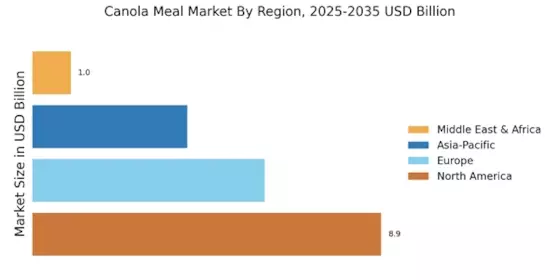Technological Innovations
Technological advancements in agricultural practices and processing techniques are likely to enhance the efficiency and quality of canola meal production. Innovations such as precision agriculture and improved extraction methods may lead to higher yields and better nutritional profiles for canola meal. In recent years, the Canola Meal Market has witnessed a surge in research and development aimed at optimizing canola varieties for higher protein content and disease resistance. This focus on technology not only boosts production efficiency but also meets the evolving demands of the livestock sector, which increasingly seeks high-quality feed options. As a result, the Canola Meal Market is expected to experience growth driven by these technological improvements.
Sustainability Initiatives
The increasing emphasis on sustainability within the agricultural sector appears to be a pivotal driver for the Canola Meal Market. As consumers and businesses alike prioritize environmentally friendly practices, the demand for canola meal, a byproduct of canola oil production, is likely to rise. This meal is not only a high-protein feed option for livestock but also aligns with sustainable farming practices. In 2025, the canola meal production is projected to reach approximately 15 million metric tons, reflecting a growing trend towards sustainable agricultural inputs. The Canola Meal Market is thus positioned to benefit from this shift, as more farmers adopt canola cultivation due to its lower environmental impact compared to other crops.
Rising Demand for Animal Feed
The escalating demand for animal feed, particularly in the poultry and aquaculture sectors, is a significant driver for the Canola Meal Market. As global meat consumption continues to rise, the need for high-protein feed sources becomes more pronounced. Canola meal, with its favorable amino acid profile, is increasingly favored by livestock producers. In 2025, the demand for canola meal in animal feed is projected to account for over 60% of total consumption, indicating a robust market potential. This trend suggests that the Canola Meal Market is well-positioned to capitalize on the growing livestock sector, as producers seek sustainable and nutritious feed alternatives.
Government Policies and Support
Government policies promoting the use of sustainable agricultural practices and renewable resources are likely to bolster the Canola Meal Market. Various countries are implementing incentives for farmers to cultivate canola, recognizing its benefits for soil health and biodiversity. Additionally, subsidies for canola production can enhance profitability for farmers, encouraging them to integrate canola into their crop rotations. In 2025, it is anticipated that supportive policies will lead to an increase in canola acreage, further driving the production of canola meal. This supportive regulatory environment is expected to create a favorable landscape for the Canola Meal Market, facilitating growth and expansion.
Health Consciousness Among Consumers
The growing health consciousness among consumers is influencing the Canola Meal Market, particularly in the context of plant-based diets. As more individuals adopt vegetarian and vegan lifestyles, the demand for plant-based protein sources is on the rise. Canola meal, rich in protein and essential nutrients, is increasingly recognized as a viable ingredient in various food products. This trend is reflected in the food industry, where canola meal is being incorporated into protein supplements and meat alternatives. The Canola Meal Market is thus likely to benefit from this shift towards healthier eating habits, as manufacturers seek to meet the needs of health-conscious consumers.


















Leave a Comment